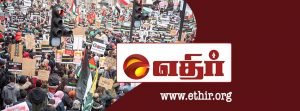Pakistan on the verge of economic catastrophe
Pakistan is left with only $8 billion in its reserves, which is enough to cover payments of imports for just 40 days. This situation has caused the highest increase in the dollar rate in the history of Pakistan. The Pakistani rupee hit a historic low against the US dollar of 137 PKR. This means that the cost of living has risen dramatically with a storm of price hikes on all utilities and essential items – an increase of at least 10% – hitting the working class and the mass of poor people.
The increase in the exchange rate of the dollar has automatically increased Pakistan’s foreign debt by 900 billion rupees. It is estimated that the price of petroleum will also increase by at least 10 to 12 rupees per litre. In a country where half of the population is living below the poverty line and millions of people are unemployed and many of the rest are underemployed, the ruling elite is forcing them to the edge of catastrophe.
The current government of Pakistan Tehreek-e-Insaf (Pakistan Movement for Justice), which came into power on the slogans of so-called “change” and demagogy against corruption, has been completely exposed in its first month. It has been clear that they have not any plan to raise prospects for the working class and poor.
The PTI head and prime minister of Pakistan, Imran Khan, said that he wouldn’t go to the International Monetary Fund. He said, “It is better to commit suicide than to approach the IMF.” But now the PTI government has formally submitted an application to fund for a bailout package of $10-12 billion, which would be the biggest-ever IMF bailout package for Pakistan.
The IMF and the US
Christine Lagarde, director of the IMF, has said: “An IMF team will visit Islamabad in the coming weeks to initiate discussions for a possible IMF-supported economic programme. We look forward to our continuing partnership”. But, on the other hand, in July, the U.S. Secretary of State, Mike Pompeo, already warned that the US didn’t want to see any IMF lending to Pakistan which might “go to bail out Chinese bond-holders or China itself”. This really means that for the PTI government in relation to the IMF “the cake is not ready to eat”.
America also wants some “serious” steps taken on various issues by the Pakistani government and establishment. But it is unclear how it can be assured and judged certain that no money from an IMF loan to Pakistan goes toward payments to China.
From a broader perspective, dealing with Pakistan is just another issue which is not on the top of the priorities list of the USA. But the US government wants to safeguard their economic and political interests in Afghanistan as well as in the whole region and Pakistan has a key role in this. The USA also wants Pakistan to crack down on banned organisations who are still strategic assets for the Pakistani “establishment”. That is why the USA is witholding $300 million in aid to Pakistan to force a change in its behaviour towards the USA-designed ‘War on Terror’. A Pentagon official, directly addressing the issue, stated that “the US military is seeking to reallocate the $300 million in aid due to Pakistan because of Islamabad’s lack of “decisive action” in support of regional American strategy”.
This is the scenario the Pakistani government and establishment find themselves in. The current PTI government was proclaiming itself as champion of so-called self-sufficiency and was relying on the expatriates’ remittances. After disappointment with expatriates who did not respond to Imran Khan’s appeal to send dollars for a Dam fund he then turned to Saudi Arabia. When the entire world boycotted the Saudi Arabian Investment Conference over Jamal Khashoggi’s murder, Imran Khan was not bothered. In return, the Saudis gave $3 billion just to keep in reserve and oil on credit for the next two years. But this is insufficient to keep the economy on track.
Now Imran Khan has gone on his official visit to China and he definitely will ask for help to his government to get rid of this grave economic situation. But realistically, the Chinese will never do anything without securing their own economic interests. Pakistan is fully caught in “debt-trap diplomacy” on all sides and is on the receiving end of pressure from among the global economic powers.
The $62 billion China–Pakistan Economic Corridor (CPEC) project is being referred to as a rescue and a foundation stone for Pakistan’s development and economic growth. It is actually is a sharp double-edged sword: China is keeping all the benefits for itself. All the equipment, machinery and other supplies will come from China, including the labour. This is the whole scenario which makes it much clearer who will benefit from it. All the ruling class parties of Pakistan eagerly want to take advantage of Chinese investment and use it to their benefit, but they never tell the whole truth to the people of the country. The whole scenario of Chinese “investment” in Pakistan will create worse conditions rather than any betterment.
Prospects
All the efforts made by the Imran Khan government will mean owing billions of dollars to “stabilise” the economic situation and paying instalments due on the IMF’s loan and interest on it. But ultimately they will be left with the only option of borrowing more loans from the IMF to pay the interest on already borrowed loans. For this, the government has started to comply with the conditions of the IMF for “restructuring” the economy; they have started cuts on subsidies, raising the cost of utilities and essential items, privatising public institutions and increasing taxes. All of this will lead to increasing poverty and unemployment rather than creating the 10 million new jobs and building 5 million houses as the PTI promised in its first 100 days plan.
It has been clear that the PTI has not got any economic plan to overcome the crises Pakistan is facing. They are proving that they are not different from the Pakistan Muslim League – Nawaz (PML-N) or the Pakistan People’s Party (PPP) whose policies are also in pursuance of a neoliberal economic agenda.
The need is for an alternative economic plan which radically reforms the fundamentals of this rotten economic structure of the country which can only be possible through a planned economy. For this, the forces of the working class need to unite and organise themselves to struggle to take power into their hands. Because the whole ruling class and its parties have common interests, they will not do it. Their politics is to protect the ruling class and their economic interests as well as to safeguard global capitalism’s interests in the country and in the region.
The working class and all the oppressed sections of society need to unite to build their own party, with a clear class-based programme, which is the only way to get rid of the crises and exploitation which the people of Pakistan have been facing for the past 70 years of the country’s existence.



















